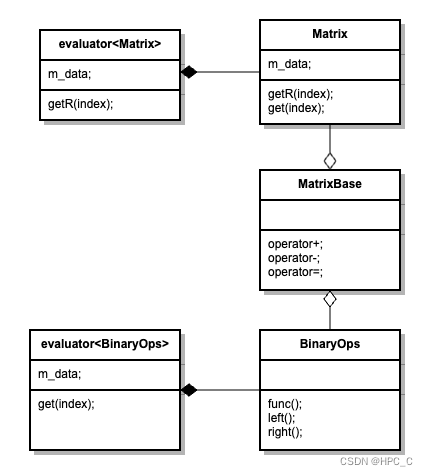1.起因
试想一种这样的情况:
Matrix<double, 4> a;
Matrix<double, 4> b;
Matrix<double, 4> c;
Matrix<double, 4> d;
for(int i = 0; i < 4; i++){
a[i] = i;
b[i] = i;
c[i] = i + 2;
}
d = a + b - c;常规解法是:先计算a+b,然后存到一个临时Matrix中,然后在计算减去c,最后将该值赋给d。这种解法的代价是:
- 多构造一个临时空间,存储a+b的值;
- 要做两遍for循环,加法和减法各一遍;
可不可以实现:
for(int i = 0; i < 4; i++){
d[i] = a[i] + b[i] - c[i];
}这就用到了我们今天要提到了表达式模板,我为了方便大家理解抽象eigen中的核心组件;具体代码位置为:https://github.com/Beichen-Wang/HPCTest/tree/master/SystemOptimizer/ExpressionTemplate
2.核心思想
核心思想是利用模板元编程,在编译时展开,重载operator=,在赋值时进行计算。
3.基本组件

主要组件就是这5个class:
- Matrix:基础的矩阵类,主要用于存储矩阵元素,其中getR和get分别返回对应位置的元素;
- BinaryOps:主要用于存储加法和减法的返回类,不直接计算,在evaluator中计算;
- MatrixBase:核心基类,重载operator+、operator-和operator=,加法和减法不进行计算,最后的返回值为BinaryOps,在operator=的时候具体计算;
- evaluator<Matrix>:通过getR得到Matrix的引用用于计算;
- evaluator<BinaryOps>::get(intdex):计算加法和减法的位置,最后得到具体的计算值;
-
typename Trait<TL>::Scalar evaluator<BinaryOps<BinaryOP, TL, TR>>::get(int Index) { return m_data.func()(m_data.left().get(Index), m_data.right().get(Index)); }
-
3.1operator=
重点介绍一下operator=,核心是调用了call_assignment,我这里面以引用的方式将evaluator作为src和dst,在general_assignment进行了赋值;
template <typename Dst, typename Src>
inline void call_assignment(Dst & dst, Src & src){
using EDstType = evaluator<Dst>;
using ESrcType = evaluator<Src>;
EDstType EDst(dst);
ESrcType ESrc(src);
using Kernel = general_assignment<EDstType, ESrcType>;
Kernel kernel(EDst, ESrc);
Assignment<Kernel, 0, Trait<Dst>::Size>::run(kernel);
}这里面值得注意的是:我运用到了模板类,这样就可以将赋值过程循环展开,也就是变成了:
d[0] = a[0] + b[0] - c[0];
d[1] = a[1] + b[1] - c[1];
d[2] = a[2] + b[2] - c[2];
d[3] = a[3] + b[3] - c[3];算是实现了一点小的优化,当然eigen中关于这部分的优化更为完备,通过自己的成本模型判断出不同的unrolling type;
enum UnrollingType {
/** \internal Do not unroll loops. */
NoUnrolling,
/** \internal Unroll only the inner loop, but not the outer loop. */
InnerUnrolling,
/** \internal Unroll both the inner and the outer loop. If there is only one loop,
* because linear traversal is used, then unroll that loop. */
CompleteUnrolling
};3.2evaluator
我刚开始很好奇,为什么eigen要搞这么麻烦,单独抽象一个evaluator类,像一般的表达式模版,直接特化operator[]不是来的简单易懂,后来我发现单独抽象evaluator类,可以实现优化,尤其涉及到矩阵乘法,试想这样一种情况:scalar * ( A * B ),理论上这种情况就需要临时变量存储A*B,但是如果遇到这种情况,改成(A*scalar) * B就不需要了。通过特化evaluator就可以实现这种方式,具体实现方式可以查看:https://github.com/libigl/eigen/blob/1f05f51517ec4fd91eed711e0f89e97a7c028c0e/Eigen/src/Core/ProductEvaluators.h#L40
4.总结
通过参考eigen,实现了自己的一个表达式模板,目前可以完成加法和减法运算,并预留了其他运算的接口。具体链接为:https://github.com/Beichen-Wang/HPCTest/tree/master/SystemOptimizer/ExpressionTemplate。其中用到的优化技巧有:
- head only:只有头文件,使用方便;
- 运用栈存储元素;
- 运用表达式模板进行lazy compute,减少访存和临时变量生成;
- 对赋值进行循环展开。






















 被折叠的 条评论
为什么被折叠?
被折叠的 条评论
为什么被折叠?








